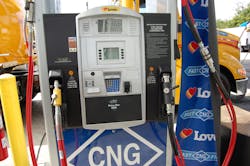Fueling infrastructure remains obstacle to natural gas expansion
Establishing a broader national refueling network for natural gas vehicles – especially those operating on compressed natural gas (CNG) – is being increasingly viewed as the key “ingredient” to spurring wider adoption of that alternative fuel by commercial fleet operations.
To that end, GE Capital Fleet Services (GECFS) recently forged agreement with VNG.co to support the expansion of the CNG refueling infrastructure for light-duty fleet vehicles.
VNG is using the GE CNG In A Box system for speedier and easier deployment of its “fast-fill” CNG fueling system into existing retail gasoline stations, eliminating the need for fleets to own and maintain their own CNG refueling locations.
“There are many ‘ingredients’ required in order for natural gas to become main-stream in light commercial fleets [and] CNG infrastructure appears to be a missing link in broader light duty fleet adoption,” Brandi Stensos, product leader for GECFS, told Fleet Owner. “Once accessible fueling infrastructure exists, maintenance suppliers and the presence of a secondary market will follow.”
She added that it’s this type of agreement that is needed to “tip the scales” in terms of convincing more fleets to switch their vehicles over the natural gas, particularly in the light-duty segment.
“Under the right circumstances, light duty fleets can see a break-even in two to five years,” Stensos noted. “Light duty commercial fleets that have deployed CNG are reporting enough benefit from the reduction in fuel prices to offset the upfront equipment costs [but] access to fueling is key for CNG utilization to occur.”
[For a detailed look at how different types of natural gas refueling locations operate, natural gas engine maker Cummins Westport developed the video below.]
According to a recent report from Navigant Research, worldwide sales of light-duty natural gas vehicles (NGVs) are expected to grow from 2.5 million annually this year to 4.2 million by 2023, with the firm stressing that the availability of a broad refueling network being critical to sustaining that growth.
“Growth in the market for natural gas vehicles is being driven by increasing supplies of low-cost, readily available natural gas, along with expanding refueling infrastructure and increasingly strict vehicle emission requirements,” noted John Gartner, Navigant’s research director. “As a result, the total number of NGVs on roads worldwide will reach nearly 40 million in the next 10 years.”
On the light-duty side of the NGV ledger, Gartner noted that in some countries – such as India, China, Thailand, and Brazil – a robust market for NGVs already exists, while in others, such as the U.S. and Germany, NGVs remain a relatively small-niche segment, though that’s expected to change in light of efforts to expand refueling infrastructure.Navigant also sees some of the same forces in play within the medium- and heavy-duty vehicle (MHDV) segment as well, with the deployment of more “fast-fill” CNG refueling locations making natural gas more attractive.
Right now, alternative fuels of all kinds – natural gas, propane, etc. – make up less than 5% of the total worldwide MHDV vehicle market today, but by 2035, Navigant expects to expand to 14%, with natural gas the top choice.
“Attractive business cases for medium and heavy duty alternative fuel vehicles are emerging across varying segments of the market,” noted Scott Shepard, a research analyst with Navigant. “Natural gas has a significant advantage over most alternative fuels, in that low fuel costs and advances in infrastructure for both liquefied natural gas (LNG)and fast-fill CNG make the fuel competitive in all market segments, including heavy duty long-haul trucking.”
Love’s Travel Centers & Country Stores is one company investing in natural gas refueling technology to help support – and win business from – fleets and individuals alike that convert their vehicles to the gaseous fuel.
The company is on track to have 16 “fast-fill” locations for heavy trucks and light vehicles alike by the end of this year and opened its latest “fast-fill” location outside Dallas, TX, just last week.
Bill Cashmareck, general manager of natural gas at Love’s, told Fleet Owner that the price differential between diesel and CNG – $3.85 versus $1.99, respectively, per equivalent gallon as of last week – is the main attraction for fleets to covert to natural gas, but that equivalent refueling times is also important.
He noted that Love’s Fast-Fill CNG offers a fill rate of greater than 10 gallons per minute, meaning a driver can fill a 100 gallon equivalent tank of CNG in 10 minutes or less.
“We’re getting that ‘trickle down’ effect right now of fleets converting trucks to natural gas because they know we have CNG refueling locations to support them,” he explained.
[Love’s recognizes, however, that establishing a truly national refueling network for natural gas won’t happen overnight, as the company’s founder Tom Love noted two years ago in the video below.]
Navigant projects that the total number of MHDVs in use worldwide will nearly double between 2014 and 2035 and while diesel will remain the primary fuel choice of MHDVs throughout that period, the percentage of MHDVs powered by diesel is expected to fall from over 79% this year to 76% by 2035.
Still, from GECFS’s perspective, many factors need to align before a “tipping point” can truly occur in terms of vehicles changing-over from petroleum-based fuels to natural gas. Those include: the fuel price differential between natural gas, diesel, and gasoline; decreased CNG vehicle costs; and a more developed “ecosystem” for NGVs.
“The fuel price differential exists today, and the vehicle costs are coming down or as noted above, break-even is attainable for some,” GECFS’s Stensos said. “Access to CNG fueling seems to be the needed catalyst in achieving broader fleet adoption.”

